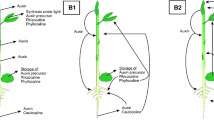Abstract.
All plants exhibit the property of cellular totipotency, whereby individual cells can regenerate into an entire organism. However little is known about the underlying mechanisms regulating totipotency. Using a preparative microtechnique, we report an 80-fold surge in the concentration of free auxin that is correlated with the initial stages of zygotic embryogenesis in carrots. The concentration of free IAA increases from a basal level of ca. 25 ng/g FW in unfertilized ovules to ca. 2,000 ng/g FW in the late globular and early heart stages, then back to the basal level in the torpedo stage. This initial increase in IAA levels is diagnostic of the activity of the tryptophan-mediated pathway for IAA biosynthesis, while the maintenance of the basal levels is attributed to the tryptophan-independent pathway for IAA biosynthesis. Our observations are consistent with the hypothesis that the sequential activation of alternative IAA biosynthetic pathways is a critical mechanism for regulating carrot (Daucus carota L. cv. Danvers 126) embryogenesis and other instances of plant totipotency.
Similar content being viewed by others
Author information
Authors and Affiliations
Additional information
Electronic Publication
Rights and permissions
About this article
Cite this article
Ribnicky, D.M., Cohen, J.D., Hu, WS. et al. An auxin surge following fertilization in carrots: a mechanism for regulating plant totipotency. Planta 214, 505–509 (2002). https://doi.org/10.1007/s004250100639
Received:
Accepted:
Issue Date:
DOI: https://doi.org/10.1007/s004250100639




